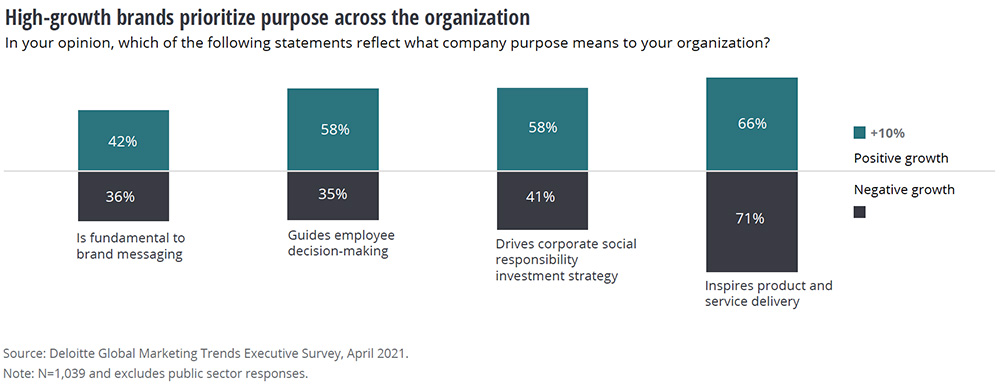As the New Year rolls in, consumers are strengthening their voices to tell brand marketers how their support can win more of their dollars. Their message is clear: make your purpose about more than corporate profit.
Deloitte’s 2022 Global Marketing Trends report pinpoints key trends unfolding in the marketing function. It uncovers how high-growth brands across the business landscape are leading the way, and it provides fresh insights to help brands navigate the path forward.
The past 18 months have redefined customer engagement strategies amid the complex macro trends unfolding in the market and within marketing organizations. In today’s world, people continuously toggle between digital and physical channels, making linear customer journeys almost a relic of the past.
Consumers have also become more guarded in how their data is captured and deployed. Still, they still expect a personalized and tailored journey that keeps both convenience and the purpose of the brand at the forefront.
This changing landscape has led marketing teams and organizations to rethink the mix of talent they need to deliver on the new expectations of consumers, noted researchers.
Business and marketing leaders are at a tipping point in terms of customer experience and engagement, noted Barbara Venneman, principal for Deloitte Consulting and Global Advertising, Marketing, and Commerce offering leader for Deloitte Digital. This year’s Global Marketing Trends report shows that the macro trends unfolding in the market are making the marketing function more complex.
“This is a profound opportunity for business and marketing leaders to steer their organization’s strategies to move ahead in their industries. Organizations must examine what comprises the basis of dynamic customer experience — people, data and experiences — and holistically rethink every engagement a brand has with their customer from start to finish,” she said.
Trend Underpinnings
Researchers found that the definition of convenience has changed as people expect items and services to be available at the push of a button. Beyond products and services, consumers are more attuned to what a brand stands for. If that stand is only maximizing profit, many will walk away before the brand can even put an offer in front of them.
Changing global trends are creating complexity within the four walls of marketing organizations as well. Artificial intelligence is becoming core to the entire customer experience.
Marketing teams are scrambling for the right talent mix that elevates and integrates the creative and analytical. Brands are continuously looking to ensure their talent is just as representative and inclusive as the experiences they hope to deliver to the market.
All the while, the reality is marketing budgets shrunk to record lows at a time when expectations are at an all-time high, according to a Gartner report released in July 2021.
2022 Marketing Trends
The Deloitte 2022 consumer report outlines key trends unfolding in the marketing function that are driving companies forward. Key findings include:
Diversity and Inclusion Is Crucial
It’s not enough to market inclusiveness or diversity as 48 percent of consumers are more loyal to brands that commit to actionably addressing social inequities, and consumers want to support brands that represent them and their values.
Human-Centered Design and Hybrid Experiences Are Key to Connection
Seventy-five percent of global executives plan to invest more in delivering hybrid experiences over the next year. Human-centered design is the best way to achieve a physical and digital mix of experiences with the personalization consumers seek.
The Marketing Profession is Becoming More Analytical
More than 550 global CMOs say the top skills of their highest performers are related to analytical expertise. As the rise of big data and artificial intelligence changes the demands of the marketing profession, leaders need to find the right talent structure for their unique objectives.
First-Party Data Investment
With the loss of third-party cookies, it is no surprise that high-growth brands are taking the lead in the shift to a first-party environment. Marketing executives could benefit from investing in first-party data strategies, designing human-centric experiences, and forming deep relationships with ecosystem partners to gain access to walled gardens of data and corresponding insights.
Deloitte took a comprehensive look at the future of the marketing function following 18 months of some of the greatest challenges and changes that most organizations have ever faced, observed Jennifer Veenstra, managing director, Deloitte Consulting and executive leader of Deloitte’s Global CMO program.
“By studying the strategies of high-growth brands, we have uncovered insights that can equip business and marketing leaders with a roadmap for using marketing as a force for creating exceptional customer experiences and delivering growth for their organizations,” she said.
DEI Must Be Addressed
The report defines high-growth brands as those with 10 percent or higher annual growth and commitment to an integrated purpose that mirrors stakeholder needs to gain a competitive advantage.
It details a holistic approach to purpose, one that is more equitable and inclusive across all stakeholders. That direction requires brands to put a premium on accountability and establish key performance metrics anchored around their purpose.
Researchers found that consumers now demand more than inclusiveness or diversity within a business. The report shows 57 percent of consumers are more loyal to brands that commit to actionably addressing social inequities.
The contours of our society are changing. Marketers should champion diversity, equity, and inclusion to underpin brand messaging with authenticity, according to the report.
With a mix of physical and digital experiences becoming the norm, three-fourths of surveyed global executives plan to invest more in delivering hybrid experiences over the next year. The best place for leaders to start is with human-centered design, which can marry the best of physical and digital while giving consumers greater choices.
Polling over 550 global CMOs revealed that analytical experience was identified more often than creative expertise as a leading skill of their highest-performing firms. Historically pegged as a field for creatives, the rise in big data and AI has changed the demands of the marketing profession. Business leaders now need to find the right talent structure for their unique objectives.
Brands must work harder to build dynamic, strong connections with their customers to thrive, according to Stacy Kemp, principal, Deloitte consulting and marketing and customer strategy leader.
Methodology Matters
Researchers conducted two global surveys and 18 in-depth interviews with global executives. They polled 1,099 C-suite executives from global companies located in the United States, the United Kingdom, France, Japan, and the Netherlands in April 2021. Also surveyed were chief executives, marketing, information, finance, operating, legal, and human resource officers.
All businesses (outside of the public sector) had at least US$500 million in annual revenues, with 73 percent having over US$1 billion. The consumer survey polled 11,500 global consumers, ages 18 and above, in May 2021 across 19 countries: the United States, Canada, Mexico, Brazil, Chile, South Africa, Sweden, the United Kingdom, Italy, Ireland, France, Spain, Turkey, Switzerland, Denmark, Portugal, Japan, India, and China.
“Our Global Marketing Trends research uncovers critical shifts in customer expectations to inform how brands can continue to move beyond point solutions to address the entire customer experience — including activating purpose and overhauling customer data strategies — to reap the success of being a high-growth organization,” Kemp said.
Purpose-Focused Growth
One glaring discovery is in changing consumer attitudes regarding the purpose of companies beyond profit-making. When asked why consumers purchased from a specific brand, respondents cited either price or quality among the top three purchasing criteria almost every time. However, researchers found that purpose-related factors become competitive differentiators for the third top criterion.
Globally, having more than half of all respondents indicating their loyalty to brands that commit to addressing social inequities is highly significant. Researchers suggest that when brands know whom they are serving and what those individuals specifically care about, they can move in the direction those consumers are expecting as a competitive differentiator.
Evidence shows that brands that commit to purpose are gaining that competitive advantage. Polling 1,099 global executives found that high-growth brands are translating purpose into action in markedly different ways from their lower-growth peers.

They are looking at purpose more holistically and are capturing a new kind of growth. That growth is more equitable and inclusive across all stakeholders while tied to issues people care about.
Action Items
The Deloitte report suggests how brands can put consumer-driven purpose into action with three primary steps to gain consumer support:
1. Start with organizational “ethos.” Then, refine through stakeholder values.
Many internal facets define an organization — values, company history, products, and services offered — that also underpin its purpose. However, stakeholder expectations and values also shape that purpose.
2. Purpose requires enterprise-wide alignment and accountability.
The highest-growth brands more often measure their purpose, from product delivery to the employee review process. Establishing key performance indicators can help ensure the brand continuously keeps its purpose front and center — and aligns that purpose across the entire organization.
3. CMOs connect purpose and the customer experience.
Chief marketing officers are uniquely positioned to bring the customer voice to the organization and ensure that purpose is embedded in every customer touchpoint. Companies that continuously work to commit to mirroring their purpose to stakeholders’ needs will likely best make purpose a competitive differentiator.
The full 2022 Global Marketing Trends report is available here.
























































